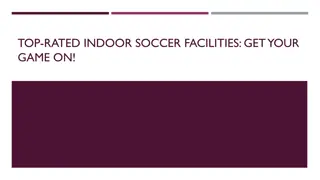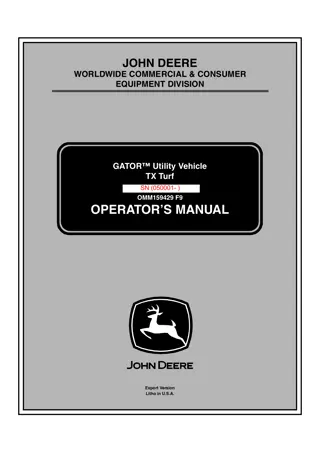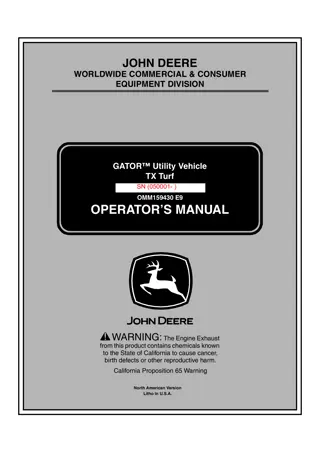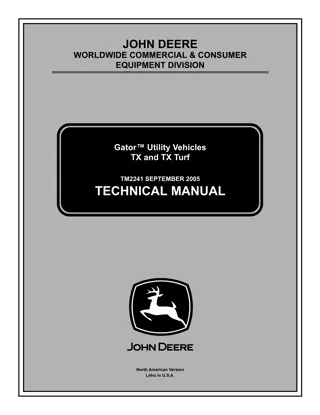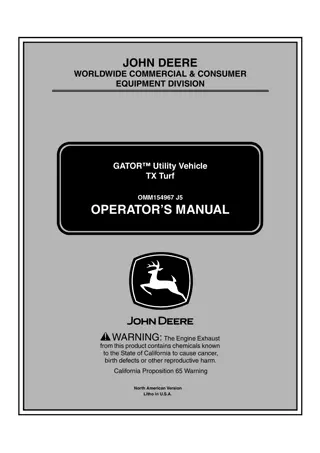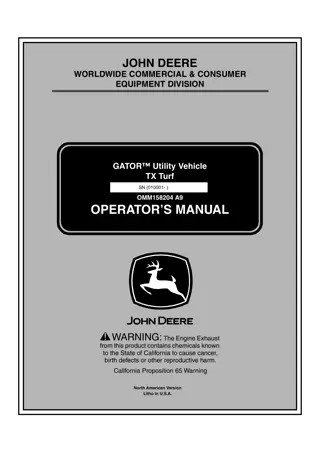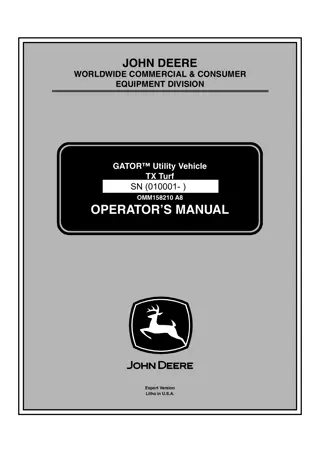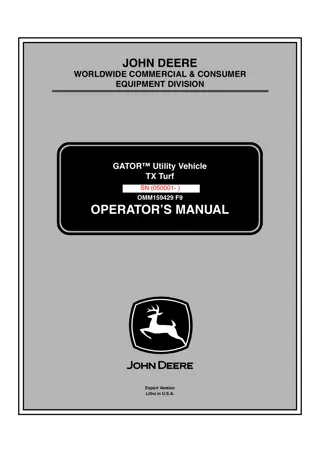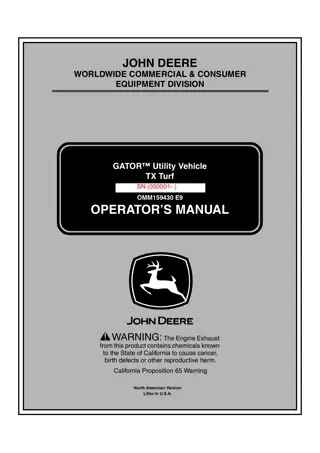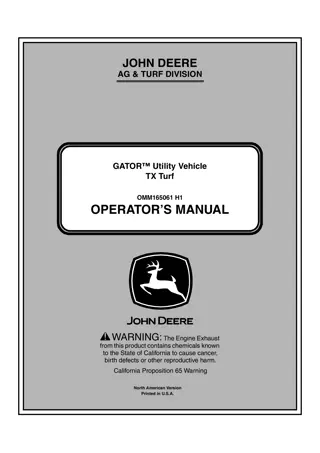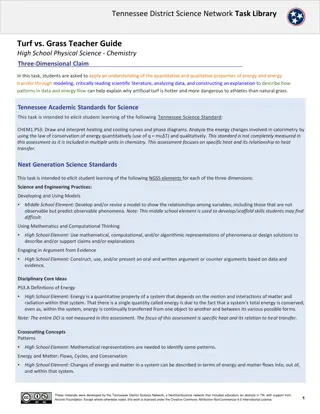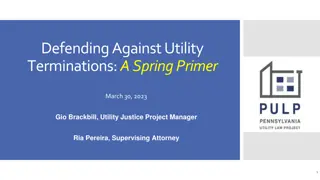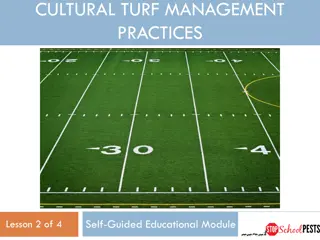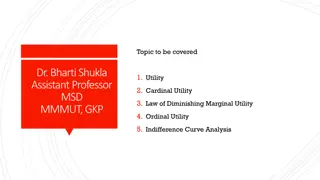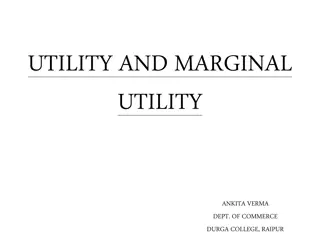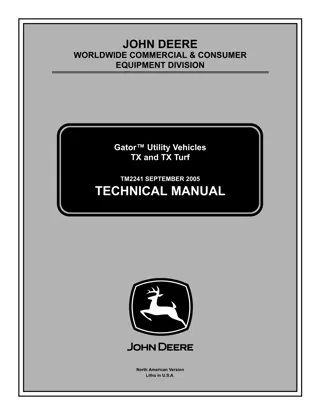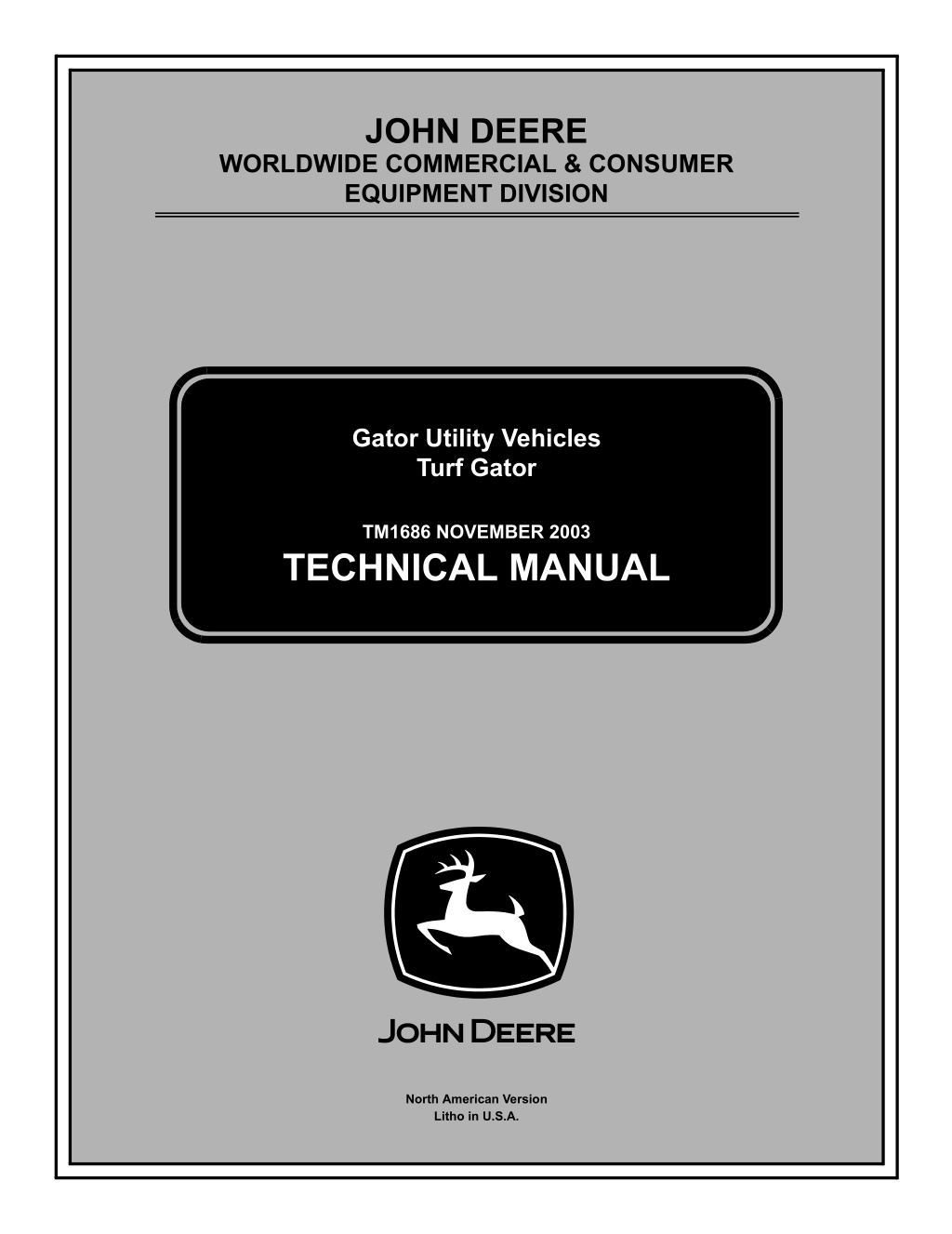
John Deere Turf Gator Utility Vehicle Service Repair Manual Instant Download (TM1686)
Please open the website below to get the complete manualnn//
Download Presentation

Please find below an Image/Link to download the presentation.
The content on the website is provided AS IS for your information and personal use only. It may not be sold, licensed, or shared on other websites without obtaining consent from the author. Download presentation by click this link. If you encounter any issues during the download, it is possible that the publisher has removed the file from their server.
E N D
Presentation Transcript
JOHN DEERE WORLDWIDE COMMERCIAL & CONSUMER EQUIPMENT DIVISION 1686 November 2003 Gator Utility Vehicles Turf Gator TM1686 NOVEMBER 2003 TECHNICAL MANUAL North American Version Litho in U.S.A.
INTRODUCTION Manual Description Introduction Safety This technical manual is written for an experienced technician and contains sections that are specifically for this product. It is a part of a total product support program. Specifications and Information The manual is organized so that all the information on a particular system is kept together. The order of grouping is as follows: Engine (FE290D) Table of Contents Specifications and Information Identification Numbers Electrical Tools and Materials Component Location Schematics and Harnesses Power Train Theory of Operation Operation and Diagnostics Steering Diagnostics Tests and Adjustments Repair Brakes Other NOTE: Depending on the particular section or system being covered, not all of the above groups may be used. Miscellaneous The bleed tabs for the pages of each section will align with the sections listed on this page. Page numbering is consecutive from the beginning of the Safety section through the last section. We appreciate your input on this manual. If you find any errors or want to comment on the layout of the manual please contact us. All information, illustrations and specifications in this manual are based on the latest information at the time of publication. The right is reserved to make changes at any time without notice. COPYRIGHT 2003 Deere & Co. John Deere Worldwide Commercial and Consumer Equipment Division All rights reserved Previous Editions COPYRIGHT 1997, 2000 Introduction
SAFETY Handle Fluids Safely - Avoid Fires Safety Recognize Safety Information Be Prepared For Emergencies MIF This is the safety-alert symbol. When you see this symbol on your machine or in this manual, be alert to the potential for personal injury. Follow recommended precautions and safe servicing practices. Understand Signal Words MIF A signal word - DANGER, WARNING, or CAUTION - is used with the safety-alert symbol. DANGER identifies the most serious hazards. heaters or other fire hazards. When you work around fuel, do not smoke or work near incinerate or puncture pressurized containers. Store flammable fluids away from fire hazards. Do not DANGER or WARNING safety signs are located near specific hazards. General precautions are listed on CAUTION safety signs. CAUTION also calls attention to safety messages in this manual. debris. Make sure machine is clean of trash, grease, and spontaneously. Do not store oily rags; they can ignite and burn Replace Safety Signs Be prepared if a fire starts. Keep a first aid kit and fire extinguisher handy. service, hospital, and fire department near your telephone. Keep emergency numbers for doctors, ambulance Use Care In Handling and Servicing Batteries MIF Replace missing or damaged safety signs. See the machine operator s manual for correct safety sign placement. MIF Safety - 1
https://www.ebooklibonline.com Hello dear friend! Thank you very much for reading. Enter the link into your browser. The full manual is available for immediate download. https://www.ebooklibonline.com
SAFETY Prevent Battery Explosions such as earmuffs or earplugs to protect against objectionable or uncomfortable loud noises. from the top of battery. Battery gas can explode. Keep sparks, lighted matches, and open flame away Operating equipment safely requires the full attention of the operator. Do not wear radio or music headphones while operating machine. across the posts. Use a volt-meter or hydrometer. Never check battery charge by placing a metal object battery to 16 C (60 F). Do not charge a frozen battery; it may explode. Warm Use Care Around High-pressure Fluid Lines Avoid High-Pressure Fluids Prevent Acid Burns strong enough to burn skin, eat holes in clothing, and cause blindness if splashed into eyes. Sulfuric acid in battery electrolyte is poisonous. It is Avoid acid burns by: 1. Filling batteries in a well-ventilated area. 2. Wearing eye protection and rubber gloves. MIF 3. Avoiding breathing fumes when electrolyte is added. Escaping fluid under pressure can penetrate the skin causing serious injury. 4. Avoiding spilling or dripping electrolyte. 5. Use proper jump start procedure. Avoid injury from escaping fluid under pressure by stopping the engine and relieving pressure in the system before disconnecting or connecting hydraulic or other lines. Tighten all connections before applying pressure. If you spill acid on yourself: 1. Flush your skin with water. 2. Apply baking soda or lime to help neutralize the acid. Search for leaks with a piece of cardboard. Protect hands and body from high pressure fluids. 3. Flush your eyes with water for 10 - 15 minutes. 4. Get medical attention immediately. If an accident occurs, see a doctor immediately. Any fluid injected into the skin must be surgically removed within a few hours or gangrene may result. Doctors unfamiliar with this type of injury should reference a knowledgeable medical source. Such information is available from Deere & Company Medical Department in Moline, Illinois, U.S.A. If acid is swallowed: 1. Drink large amounts of water or milk. 2. Then drink milk of magnesia, beaten eggs, or vegetable oil. Avoid Heating Near Pressurized Fluid Lines 3. Get medical attention immediately. Wear Protective Clothing MIF MIF Flammable spray can be generated by heating near pressurized fluid lines, resulting in severe burns to yourself and bystanders. Do not heat by welding, soldering, or using a torch near pressurized fluid lines or other flammable materials. Pressurized lines can be accidentally cut when heat goes beyond the immediate flame area. Wear close fitting clothing and safety equipment appropriate to the job. Prolonged exposure to loud noise can cause impairment or loss of hearing. Wear a suitable hearing protective device Safety - 2
SAFETY Service Machines Safely Support Machine Properly and Use Proper Lifting Equipment MIF Tie long hair behind your head. Do not wear a necktie, scarf, loose clothing, or necklace when you work near machine tools or moving parts. If these items were to get caught, severe injury could result. MIF If you must work on a lifted machine or attachment, securely support the machine or attachment. Remove rings and other jewelry to prevent electrical shorts and entanglement in moving parts. Do not support the machine on cinder blocks, hollow tiles, or props that may crumble under continuous load. Do not work under a machine that is supported solely by a jack. Follow recommended procedures in this manual. Use Proper Tools Use tools appropriate to the work. Makeshift tools and procedures can create safety hazards. Use power tools only to loosen threaded parts and fasteners. For loosening and tightening hardware, use the correct size tools. DO NOT use U.S. measurement tools on metric fasteners. Avoid bodily injury caused by slipping wrenches. Use only service parts meeting John Deere specifications. Lifting heavy components incorrectly can cause severe injury or machine damage. Follow recommended procedure for removal and installation of components in the manual. Work In Clean Area Before starting a job: Park Machine Safely 1. Clean work area and machine. 2. Make sure you have all necessary tools to do your job. 3. Have the right parts on hand. 4. Read all instructions thoroughly; do not attempt shortcuts. Using High Pressure Washers Directing pressurized water at electronic/electrical components or connectors, bearings, hydraulic seals, fuel injection pumps or other sensitive parts and components may cause product malfunctions. Reduce pressure and spray at a 45 to 90 degree angle. MIF Before working on the machine: 1. Lower all equipment to the ground. 2. Stop the engine and remove the key. Illuminate Work Area Safely 3. Disconnect the battery ground strap. Illuminate your work area adequately but safely. Use a portable safety light for working inside or under the machine. Make sure the bulb is enclosed by a wire cage. The hot filament of an accidentally broken bulb can ignite spilled fuel or oil. 4. Hang a DO NOT OPERATE tag in operator station. Safety - 3
SAFETY Work In Ventilated Area Avoid creating dust. Never use compressed air for cleaning. Avoid brushing or grinding material containing asbestos. When servicing, wear an approved respirator. A special vacuum cleaner is recommended to clean asbestos. If not available, apply a mist of oil or water on the material containing asbestos. Keep bystanders away from the area. Service Tires Safely MIF Engine exhaust fumes can cause sickness or death. If it is necessary to run an engine in an enclosed area, remove the exhaust fumes from the area with an exhaust pipe extension. If you do not have an exhaust pipe extension, open the doors and get outside air into the area. MIF Warning: California Proposition 65 Warning Explosive separation of a tire and rim parts can cause serious injury or death. Gasoline engine exhaust from this product contains chemicals known to the State of California to cause cancer, birth defects, or other reproductive harm. Do not attempt to mount a tire unless you have the proper equipment and experience to perform the job. Diesel engine exhaust and some of its constituents are known to the State of California to cause cancer, birth defects, and other reproductive harm. Always maintain the correct tire pressure. Do not inflate the tires above the recommended pressure. Never weld or heat a wheel and tire assembly. The heat can cause an increase in air pressure resulting in a tire explosion. Welding can structurally weaken or deform the wheel. Remove Paint Before Welding or Heating When inflating tires, use a clip-on chuck and extension hose long enough to allow you to stand to one side and NOT in front of or over the tire assembly. Use a safety cage if available. Avoid potentially toxic fumes and dust. Hazardous fumes can be generated when paint is heated by welding, soldering, or using a torch. Do all work outside or in a well ventilated area. Dispose of paint and solvent properly. Remove paint before welding or heating: If you sand or grind paint, avoid breathing the dust. Wear an approved respirator. If you use solvent or paint stripper, remove stripper with soap and water before welding. Remove solvent or paint stripper containers and other flammable material from area. Allow fumes to disperse at least 15 minutes before welding or heating. Check wheels for low pressure, cuts, bubbles, damaged rims or missing lug bolts and nuts. Avoid Harmful Asbestos Dust Avoid breathing dust that may be generated when handling components containing asbestos fibers. Inhaled asbestos fibers may cause lung cancer. Components in products that may contain asbestos fibers are brake pads, brake band and lining assemblies, clutch plates, and some gaskets. The asbestos used in these components is usually found in a resin or sealed in some way. Normal handling is not hazardous as long as airborne dust containing asbestos is not generated. Safety - 4
POWER TRAIN - GEAR COMPONENT LOCATION Component Location Cable Components B A C D E J I H F G D - Shift Linkage E - Reverse Cable F - Shift Quadrant G - Shift Lever MX1372 A - Governor Cable B - Pedal to Transaxle Cable C - Compression Spring Power Train - Gear Component Location - 116
POWER TRAIN - GEAR COMPONENT LOCATION H - Pedal I - Forward Cable J - Neutral Lock (Alignment Hole) Drive Components B A C D E F H G M87768 A - Shift Linkage B - Governor Shaft C - Secondary Clutch D - Axle Housing E - Brake Arm F - Transaxle G - Drive Belt H - Primary Clutch Power Train - Gear Component Location - 117
POWER TRAIN - GEAR COMPONENT LOCATION Transaxle Components B C A D E F G I J H K O L N M Z AC Q AA S T P R D E X AB U W AD AE Y V AF T AG S AJ AB AH AM AK AL AI AN AO P - Nut, Flange Head Q - Lock Collar Assembly R - Gear, Final Drive S - Seal, Oil T - Bearing U - Differential Assembly V - Gear, Ring W - Transaxle Housing, LH X - Plug, Rubber Y - Nut, Lock Z - Screw, Flange Head (Short) AA- Transaxle Housing RH AB- Bearing, Input Shaft AC- Shim(s) AD- Screw, Retaining** AE- Governor Shaft Assembly** M87840 A - Seal, Governor Shaft** B - Fitting, 90 Elbow C - Screw, Flange Head (Long) D - Bearing E - Washer F - Gear, Splined Pinion G - Gear, Final Drive H - Shaft, Drive Gears I - C-Clip J - Washer, Tabbed* K - Gear, Reverse Idler L - Washer* M - Support Bearing N - Pin, Alignment O - Screw, Flange Head Socket Power Train - Gear Component Location - 118
POWER TRAIN - GEAR COMPONENT LOCATION AF- Actuating Sleeve Assembly AG- Input Shaft and Governor (Backing Plate) Assembly AH- Rod, Shift Assembly AI- Lock Fork Assembly AJ- Seal, Actuator Shaft AK- Set Screw*** AL- Spring*** AM- Ball Bearing*** AN- Seal, Input Shaft AO- Screw, Flange Head * Included in Thrust Washer Kit ** Included in Governor Actuator Kit *** Included in Detent Kit Power Train - Gear Component Location - 119
POWER TRAIN - GEAR THEORY OF OPERATION Theory of Operation Clutch Operation D C K I B J H E F G A flyweights (G) force the primary clutch to up-shift, moving the drive belt to outer pulley diameter, overcoming secondary clutch spring. Drive belt then is pulled deep in secondary clutch giving a low ratio, similar to a high gear. M56089 Theory of Operation: The variable clutch system is speed and load sensitive. The primary (A) and secondary (B) clutches work together, automatically up-shifting (C) and back-shifting (D). This shifting changes the ratio between the clutches, allowing the engine to operate at optimum efficiency, at the peak of its power curve. High Engine RPM, Increasing Load, Lower Output Speed: Back-shifting occurs as a load is encountered, such as a hill or soft terrain. The stationary side of the secondary clutch resists forward movement of the wheels, at the same time, torque from the drive belt moves the moveable sheave (H) up the ramp. The ramp buttons (I), ramp (J), and spring (K) forces the belt to the outside diameter of the secondary clutch, and overcomes centrifugal forces of the primary clutch causing the back-shifting. The primary clutch is engine speed sensitive, and is mounted on the engine crankshaft. It operates on the principle of centrifugal force. The secondary clutch, mounted on the transaxle input shaft, is load sensitive to the rear drive wheels. Engagement RPM, Minimum Load, Low Output Speed (E): Primary clutch sheaves are moving closer together, just starting to move drive belt. Drive belt is running at the top of secondary clutch. A high ratio between the clutches exist, similar to a low gear, as long as there is a minimum load. High Engine RPM, Light Load, High Output Speed (F): As engine speed increases, centrifugal forces of the Power Train - Gear Theory of Operation - 120
POWER TRAIN - GEAR THEORY OF OPERATION Transaxle Component Location and Operation Transaxle Neutral Lock Function: The transaxle provides: A a means for shifting into forward and reverse; differential action between axles for turning. C Neutral (LOCKED IN Position): D When locked into neutral (see Transaxle Neutral Lock below) the shift lever centers the shift collar between the forward drive gear, and reverse drive gear, so they are not engaged. The input shaft rotates freely, not transferring power to the reduction gear shaft. B M87843 Early Models Forward Power Flow: When shifted into the forward position the shift collar engages the forward drive gear. Power is transmitted through the reduction gear shaft that is in constant mesh with the differential gear. The differential gear and housing rotate and transfer power through the bevel pinion and side gears to the axles. A Reverse Power Flow: When shifted into reverse, the shift collar engages the reverse drive gear, that transmits power through the reduction gear shaft that is in constant mesh with the differential gear. Power is then transferred through the differential to the axle. C B D MX1440 Late Models There is NO Neutral Position on the shift lever. To LOCK transaxle in NEUTRAL a 6 mm bolt (A) and nut (B) or 1/4 bolt and nut are used in the shift linkage (C) located on top of the transaxle. For testing purposes, or towing, a 6 mm or 1/4 bolt is inserted through the shift linkage, an added nut and the shift linkage bracket (D). The nut prevents shearing pressure from moving the bolt away from a vertical position. DO NOT tow vehicle without installing 6 mm bolt and nut. Power Train - Gear Theory of Operation - 121
POWER TRAIN - GEAR DIAGNOSTICS Diagnostics System: Drive Train (1) Is the primary clutch disengaged with the engine running? Drive System Diagnosis Yes - Go to next step. Test Conditions: No - Check engine idle rpm. Adjust idle to specification if needed. If engine rpm is to specification, repair or replace clutch. Front wheels blocked Rear wheels jacked off floor Engine OFF Test Conditions: System: Drive Train Wheels blocked (1) Is the drive belt in good condition? Lock on page 121. Transaxle LOCKED in Neutral. See Transaxle Neutral Yes - Go to next step. Engine running No - Replace drive belt. Accelerate engine to 1600 rpm (2) Do the rear axles rotate smoothly and quietly with no free play in axles, bearings or housings? System: Drive Train Yes - Go to next step. (1) Does the primary clutch engage drive belt at 600 - 700 engine rpm? No - Check axles and housings. Check axle couplers. (3) Are the brakes dragging? Yes - Go to next step. Yes - Adjust brakes. See Brake Adjustment on page 167in the Brake section. No - Check drive belt, replace as necessary. Repair or replace primary clutch. No - Go to next step. Test Conditions: Test Conditions: Wheels blocked Front wheels blocked Lock on page 121. Transaxle LOCKED in Neutral. See Transaxle Neutral Rear wheels jacked off floor Engine running at fast idle Engine running System: Drive Train System: Drive Train (1) Does the primary clutch movable sheave move toward the stationary sheave? (1) Does the transaxle shift smoothly into forward and reverse and stay in gear during operation? Yes - Go to next step. Yes - Go to next step. No - Repair or replace primary clutch. No - Shut off engine and allow engine to cool. Adjust shift linkage. See Transaxle Shift Cable Adjustment on page 123. Retest. (2) Do the secondary clutch sheaves separate? Yes - Go to next step. No - Repair or replace secondary clutch. Test Conditions: (3) With the secondary clutch fully up-shifted, do the primary clutch sheaves close completely? Note: the drive belt will not ride at the top of the primary clutch sheaves when they are fully closed. Wheels blocked Lock on page 121. Transaxle LOCKED in Neutral. See Transaxle Neutral Engine running Yes - End of tests. Power Train - Gear Diagnostics - 122
POWER TRAIN - GEAR TESTS AND ADJUSTMENTS Transaxle Shift Cable Adjustment System: Drive Train No - Check center distance between clutches. See Check/Adjust Clutch Center Distance on page 34 in the Engine section. Repair or replace drive and/or secondary clutches. Reason: To insure both forward and reverse gears will be completely engaged. Procedure: Tests and Adjustments Drive Belt Check E Reason: To check drive belt wear and condition of drive belt. B Procedure: C D A F MX3911 E M87739 1. Measure drive belt width. Drive belt must not be less than 27 mm (1-1/16 in.). 2. Check drive belt condition. Drive belt must not be cracked. Some amount of glazing is normal. B C Results: If drive belt less than specification, replace. D A performance complaint, check primary clutch and secondary clutch. See Drive System Diagnosis on page 122. If drive belt is within specification, and there is a F MX1439 MX1439 1. Remove jam nut (A), nut (B), and install new springs (C) on shift cable rods (E) against original spacer (D). Install nut (B) onto first few threads of rod. 2. Push shift lever in operator s station down into forward position. NOTE: To assure that the gears are NOT engaged while holding the transaxle shift arm in the forward position, rotate the secondary clutch by hand until the transaxle pops into gear and then note the position of the transaxle shift arm. This will give a reference point to help determine the lever position when the gears are NOT aligned. Ensure that the NOT aligned position is Power Train - Gear Tests and Adjustments - 123
POWER TRAIN - GEAR TESTS AND ADJUSTMENTS achieved. Procedure: 1. Place transaxle in forward gear with park brake off. c CAUTION: Avoid Injury! Rear wheels will rotate during test. Keep clear! 3. Make sure that the shift arm (F) is rotated in the forward direction but that the gears are NOT engaged. 4. Hold the shift cable with clamps to avoid twisting while tightening the adjusting nut (B) until the forward spring is completely compressed. DO NOT continue to tighten the nut beyond the point where the operators station shift lever starts to move. 2. Block front wheels. Raise rear wheels slightly off ground with axles safely supported on jack stands. 3. Start engine. 5. Rotate secondary clutch by hand until the shift arm pops into gear. 4. Slowly increase engine rpm. Observe engine rpm when clutch starts to engage and move drive belt. 6. Move the shift lever to the reverse position, but gears are NOT engaged. 7. Hold the shift cable with clamps to avoid twisting while tightening the adjusting nut (A) until the reverse spring is completely compressed. DO NOT continue to tighten the nut beyond the point where the operators station shift lever starts to move. B 8. To test that adjustment was done correctly, move shift lever into forward then rotate secondary clutch by hand and check that it pops in gear when aligned. Repeat for reverse. A 9. Install jam nuts (A) on both rods, and tighten against adjusting nuts to lock in place. M87842 Engagement And Full Up Shift Check 5. Accelerate from idle to wide-open-throttle and back to idle several times. Watch drive belt for a smooth transition from bottom to top of primary clutch (A). Watch closely for any hesitation or engine surging. Reason: To determine if the engine and drive train are operating at peak performance. c CAUTION: Avoid Injury! Engine exhaust fumes can cause sickness or death. If it is necessary to run an engine in an enclosed area, remove the exhaust fumes from the area with an exhaust pipe extension. 6. When approaching idle, watch for a positive disengagement from drive belt. NOTE: On clutches with some hours of use, system may not disengage as smoothly due to primary clutch spring taking a set and other wear in the drive components. 7. Shut off engine. If you do not have an exhaust pipe extension, open the doors and get outside air into the area. Results: between 600 700 rpm. Drive belt should be riding high in primary clutch (A) and low in secondary clutch (B). Clutch should slowly start to engage and move drive belt Conditions: Cargo box raised. hesitation, or clutch noise (chirping); perform primary clutch lubrication. Check primary clutch for flyweights binding, pivot pins worn, flat spots on rollers or rollers sticking, and no groove in sheave. Repair or replace primary clutch. If clutch has harsh engagement, erratic transition, supported safely on jack-stands. Indoor testing - rear wheels off ground and vehicle Front wheels blocked. Tachometer displaying engine speed. performance. If engine is surging; check engine and governor Pedal Cable on page 32 in Engine section. Engine throttle cable set correctly. See Adjust Throttle clutch is good. Go to Secondary Clutch Back-Shifting Check . Smooth engagement and transition (up-shift), primary Drive belt width at or above minimum specification. Engine warmed up. Power Train - Gear Tests and Adjustments - 124
POWER TRAIN - GEAR TESTS AND ADJUSTMENTS Secondary Clutch Back-Shifting Check driven clutch), See Secondary Clutch Spring Torsion Check below. Reason: load on drive train, such as an engaged brake or failed axle bearings. See Brake Adjustment on page 167 in the Brake section. Check secondary clutch for complete up-shift. Check for To determine condition of secondary clutch and back- shifting performance. Conditions: Engine throttle should open 100%. Cargo box raised. Secondary Clutch Spring Torsion Check supported safely on jack-stands. Indoor testing - rear wheels off ground and vehicle Reason: Front wheels chocked. Verify condition and spring adjustment of secondary clutch. Tachometer displaying engine speed. Conditions: Procedure: c CAUTION: Avoid Injury! Rear wheels will rotate during test. Keep clear! Transmission in gear. Park brake set. Drive belt removed. 1. Rear wheels off ground at least one in. and axles safely supported on jack stands. Block front wheels. Procedure: IMPORTANT: Avoid damage! Do not damage sheave when clamping locking pliers. Use protective strips of brass or aluminum. 2. Transaxle in forward and park brake OFF. Start engine. 3. Operate engine at wide open throttle. Results: A B C A D B M87842 M87851 speed. Drive belt should be riding high in primary clutch (A) and low in secondary clutch (B). Engine and wheel speed should remain at constant 90 A Procedure: 1. Momentarily load power train by slowly applying foot brake until back-shift is made. B 2. Quickly observe engine speed, then release brake. Results: Clutches should back-shift as brake is increased. Drive belt should not squeal or slip. mif If clutches do not back-shift completely (belt is at top of Power Train - Gear Tests and Adjustments - 125
POWER TRAIN - GEAR REPAIR Repair 1. Clamp locking pliers (A) to movable (inboard) sheave. 2. Using spring scale (B) hooked into jaw of locking pliers as close to sheave edge as possible, measure the force required to rotate the movable sheave. Force measurement is taken while returning cam to closed position right before buttons (C) touch. Primary Clutch Removal IMPORTANT: Avoid damage! Lightly grease (A) end of puller (B) to help prevent puller wear. To prevent clutch thread damage, DO NOT thread bolt in any farther than necessary to remove clutch. Specification: Standard Wrap Brown Spring . . . . . . 22 - 20 N (5 - 9 lb) Standard Wrap Green Spring . . . . 62 - 80 N (14 - 18 lb) 1. Remove black plug in front of rear tire on left side of frame. NOTE: Standard torsion spring (D) installation sets spring tab in hole 2 in moveable sheave half. Due to variations in the spring rate of the torsion spring, the spring tab may be factory set in holes 1 or 3 . 2. Remove drive belt. A Results: OK. Check engine rpm and performance. Spring force within specification; secondary clutch is M56704 B M56704 3. Remove plastic plug from clutch cover. faster and engine load greater, reducing engine rpm and response time. Check spring position, set spring tab in next higher number hole, (i.e. move from hole 2 to 3 ) and re- check spring force. Replace spring if still not within specifications. Spring force less than specification, up-shift will be 4. Remove clutch mounting bolt and washers. 5. Use JDG813-1A Clutch Removal Tool (B). Thread puller into clutch and against crankshaft. Tighten until clutch pops free from crankshaft taper. NOTE: An air impact wrench works well to remove the primary clutch. acceleration will be slower, reducing engine load, increasing engine rpm and response time. Check spring position, set spring tab in next lower number hole, (i.e. move from hole 2 to 1 ) and recheck spring force. Replace spring if still not within specifications. Spring force higher than specification, up-shift or 6. Install clutch in reverse order of removal. Tighten clutch bolt to 40 8 N m (24 35 lb-ft). Primary Clutch Repair 1. Remove clutch cover bolts. Remove cover. (Cover should pop off; do not pry on cover.) 2. Install JDG813-3 Tapered Holding Tool (A) and retain it with a M10 X 1.5 X 150 mm hex-head bolt. 3. Place an index mark on the spider and movable sheave with black marker. IMPORTANT: Avoid damage! Always use JDG813-2 Spanner Wrench (B) to remove spider. Unequal pressure on clutch towers could cause stress fractures or break them off. A medium strength thread lock is used on spider threads. Power Train - Gear Repair - 126
POWER TRAIN - GEAR REPAIR B N G MX1402 6. Check for flat spots or binding of spider rollers (J). Replace as necessary. 7. Use a medium strength thread lock on the spider threads during assembly. Tighten to 136 13 N m (100 10 lb-ft). A Secondary Clutch Removal and Installation 1. Remove drive belt. 2. Hold clutch with a strap wrench, and remove cap screw (A) and bushing (B). 3. Tap on inside of clutch with a rubber mallet. M56706 M56708 4. Remove secondary clutch (C). 4. Use JDG813-2 Spanner Wrench (B) to remove spider. NOTE: If buttons (I) or rollers (J) are excessively worn, order button and roller replacement kit AM130222. A C D C E B M M87754 5. Installation is done in the reverse order of removal. equivalent, to splines of transaxle input shaft. Apply Moly High Temperature EP Grease, or I L F I H K and Sealer to original cap screw. New cap screw will have Thread Lock applied. Install new mounting cap screw or apply Thread Lock J G M56707A Tighten cap screw to 75 7 N m (50 60 lb-ft). 5. Replace pivot bolt (G) if worn through plating. Check cam weight (H) for binding. Secondary Clutch Disassembly NOTE: 14.2 mm wide cam weights (H) have plastic thrust washers (N) inserted on each side of the cam weight. 1. Release tension on spring (A) by prying spring out of hole (B) in cam. 2. Remove set screw (C). NOTE: Cam is press fit on shaft. Use a three-jaw puller and an impact wrench, at low speed, to remove cam from shaft. Power Train - Gear Repair - 127
Suggest: If the above button click is invalid. Please download this document first, and then click the above link to download the complete manual. Thank you so much for reading
POWER TRAIN - GEAR REPAIR ramp, remove tabs using a drill bit. If button mounting tabs break off inside holes in C B loose, apply thread lock and sealer (medium strength) on tabs. Install ramp button tabs into ramp holes. If tabs are E C A A D B M82418 3. Place alignment marks (D) on cam (E) and movable sheave to aid in assembly. c CAUTION: Avoid Injury! Hold cam securely to prevent sudden spring release. M82422 2. Inspect bushing (C) for wear or damage. Replace movable sheave if necessary. Secondary Clutch Assembly 1. Install spacer and movable sheave on fixed sheave. A B D C M87753 4. Remove cam using a three-jaw puller and impact wrench. NOTE: Before removing spring, mark the hole on the sheave that the spring tab is installed in (i.e 1, 2, 3 or 4). M82421 2. Install spring. Insert spring tab into previously marked hole (A) in movable sheave. Place cam on spring. 5. Remove spring, movable sheave and spacer from shaft. 3. Align set screw bores (B) and alignment marks (C). Press cam on shaft until it stops. NOTE: Ramp buttons are mounted with tabs on backside. Tabs are interference fit into holes on face of ramps. Remove buttons only if replacement is necessary. 4. Apply thread lock and sealer (medium strength) to threads of set screw and install. 5. Pry spring away from cam and loop a piece of string (D) around top spring tab. Pull on string until tab seats in hole in cam. Secondary Clutch Inspection 1. Inspect six ramp buttons (A) for wear or cracks. To replace buttons: 6. Re-check spring torsion. See Secondary Clutch Spring Torsion Check on page 125. mounting tabs release from holes in ramp. Pull off buttons. Apply heat to movable sheave ramp (B) until button Power Train - Gear Repair - 128
https://www.ebooklibonline.com Hello dear friend! Thank you very much for reading. Enter the link into your browser. The full manual is available for immediate download. https://www.ebooklibonline.com

